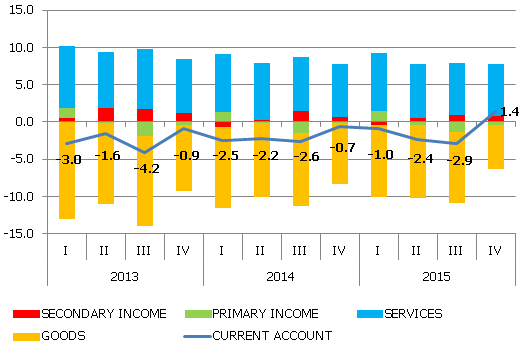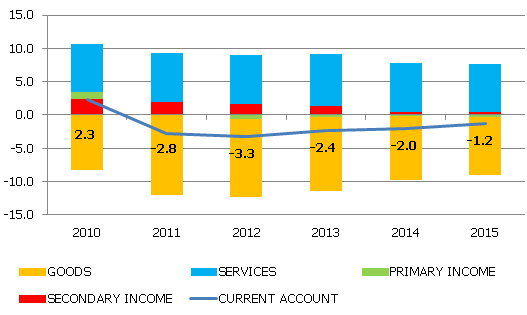In the fourth quarter of 2015, a surplus, 1.4% of GDP, in Latvia's current account
In the fourth quarter of 2015, as well as in 2015 overall, the current account has posted an improvement, mostly as a result of the dynamic of goods balance. This, however, is primarily a sign of the contraction of goods imports as a result of the weak domestic investment activity and export development as well as the dropping global prices. At the same time, we should note that in 2015, under the conditions of a weak external demand, goods exports maintained positive growth. In the fourth quarter of 2015, there was a surplus of 90.6 mil. euro or 1.4% of gross domestic product (GDP) in the current account; in the third quarter, the deficit was 2.9% of GDP. The current account deficit in 2015 overall decreased to 299.5 mil. euro or 1.2% of gross domestic product (GDP) (In 2014 overall, this indicator was -466.8 mil. euro or 2.0% of GDP). Consequently, the goods and services trade balance in 2015 overall improved year-on-year and had a deficit of 347.2 mil. euro or 1.4% of GDP.
Chart 1. The main components of current account, % of GDP

Source: Latvijas Banka Statistical Database
As the deficit in the goods balance continued to contract in the fourth quarter of 2015, (to 379.9 mil. euro or 5.9% of GDP) and indicated the fastest quarter-on-quarter decrease in the last five years, also in 2015 overall, the goods balance improved (deficit dropped to 2.1 bln. euro or 8.7% of GDP; in 2014, this indicator was 9.6% of GDP). Such development resulted from a small positive growth of goods export (in 2015, a 1.0% growth year-on-year), with goods import simultaneously dropping (0.5% year-on-year decrease). The decrease in goods import over the entire year was determined by decreases in the majority of import goods groups, which is primarily related to the drop in raw materials prices in the world, the slow development of export, which resulted in a smaller demand for intermediate consumption goods, as well as weak investment activity. The drop in imports was the most pronounced for mineral products, textile materials and metal products. The rise in goods exports was fostered by the favourable developments regarding such goods groups as mechanisms and mechanical equipment, plant derived products, chemicals and wood and export of wood products as well as the acquisition of new markets. In a positive development, the operational data of the World Trade Organization point to an increase in Latvia's goods export market shares in world import. We should also note the success in the production and export of innovative products, for example, the flying drone AirDog. Among export-promoting factors were also the record-high grain harvest and the strategy carried out in previous years in the wood industry, fostering investment, which currently ensures growth in productivity.
Services balance remained close to the previous year's level both in the fourth quarter of 2015 and in the year overall (4Q - 452.7 mil. euro or 7.0% of GDP and in 2015 - 1.76 bln. euro or 7.2% of GDP; 1.74 bln. euro or 7.4% of GDP in 2014). In 2015, service exports posted growth of 4.9%. Both in the year overall and in the fourth quarter, it was mostly trips, but also financial services, telecommunications and IT services and other services of economic services that posted growth.
Even though the number of tourists from Russia dropped in 2015, the drop was compensated by an increase in the number of guests from the European Union (EU) countries. The increase was fostered by such events as Latvia's presidency of the EU Council as well as the European Basketball Championships, which took place in Latvia in 2015. The export of services in 2015 was unfavourably impacted by the developments in transport and construction services, which was also observed in the last quarter of 2015. The rail transport services contracted because of a drop in freight traffic amounts related to the deterioration of the economic situation in Russia. Road transport services post an increase in the number of granted services, but their prices dropped. The drop in construction services export was impacted mostly by the weakening of the construction sector in the most important partner countries, for instance, Lithuania, the United Kingdom and Finland.
The deficit in the primary income account in the fourth quarter contracted quarter-on-quarter, amounting to 29.2 mil. euro or 0.5% of GDP. Yet in the previous year overall, the negative balance of initial income rose slightly, reaching 69.6 mil. euro or 0.3% of GDP (-39.9 mil. euro or 0.2% of GDP in 2014). Compared to 2014, the inflows of EU fund subsidies increased in the initial income account and the government interest payments decreased, yet the reinvested profits of foreign direct investors and the amount of dividends received by Latvian direct investors from abroad increased, which caused the negative balance to increase slightly.
The surplus of secondary income in the fourth quarter diminished slightly, amounting to 47.0 mil. euro or 0.7% of GDP. In 2015 overall, a slight improvement, reaching 117.3 mil. euro or 0.5% of GDP (103.1 mil. euro or 0.4% of GDP 2014) was observed. The inflows of financing from the European Fisheries fund in 2015 were slightly lesser compared to the previous year but they were counterbalanced by increased inflows from the European Social Fund and other EU funds.
In the capital account in the fourth quarter, a decrease in inflows was observed (the positive balance against GDP was 105.7 mil. euro or 1.6%). In 2015 overall the positive balance of the capital account was also smaller than in 2014 (684.0 mil. euro or 2.8% of GDP, compared to 753.7 mil. euro or 3.2% of GDP in 2014). Inflows were smaller from the European Regional Development Fund, which are earmarked for improving public infrastructure and fostering business activity, and from the Cohesion Fund (infrastructure development projects in the areas of environmental protection and transport).
The financial account balance was negative both in the fourth quarter and in 2015 overall (61.6 mil. euro or 1.0% of GDP and 154 mil. euro or 0.6% of GDP). Assets abroad dropped slightly more rapidly than liabilities, and thus funds flowed into Latvia. The most important transactions both in the fourth quarter of 2015 and in the year overall were related to the items of portfolio investments and other investments. In March 2015, the central banks of the Eurosystem, launched the Expanded Asset Purchase Programme (EAPP), under whose auspices, Latvijas Banka purchased debt securities of the Latvian state and international organizations. Primarily under the impact of the above programme, the portfolio investment assets in the form of debt securities increased. Important inflows consisted also in credit institution investments in debt securities, yet much greater was the decrease in the deposits of credit institutions with foreign banks. In 2015, the greatest flows in the government sector were related both to the repayment of a part of the international loan by the European Commission and with the emission of euro securities in the external market.
Foreign direct investment increased by 577.9 mil. euro or 2.4% of GDP (in fourth quarter, by 1.0% of GDP; in 2014, by 1.9% of GDP) in 2015. The most important investment in the year overall flowed in from Cyprus, Russia, Norway and the Netherlands, and, in a breakdown by branch, investments were greatest in the financial, trade and transport branches.
Chart 2. The main components of current account, % of GDP

Source: Latvijas Banka Statistical Database
Textual error
«… …»




